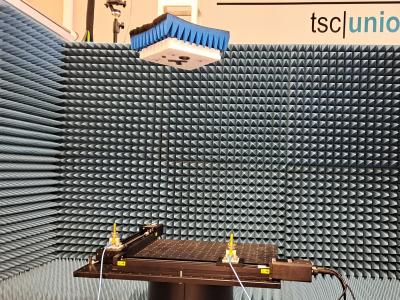Synthetic Aperture Radar
This dataset contains samples of the scattered field from a set of flat metallic objects. It includes several files corresponding to eight different measurement planes, where the distances between the plane containing the antennas and the plane containing the targets are 74.3913 cm, 66.4120 cm, 61.4173 cm, 56.4063 cm, 51.4131 cm, 46.3873 cm, 41.4244 cm, and 36.4289 cm. The measurement setup corresponds to a multistatic L-shaped configuration.
- Categories:
 224 Views
224 ViewsThe present contribution consists of two files. The first one (measurements_25GHz_11planes.mat) contains a series of measurements of the scattered electric field using two two-dimensional objects made of aluminum foil as targets. The dataset consists of S21 paramenter measurements, captured with a VNA at a frequency of 25 GHz. The field was sampled in 11 planes located at different distances from the plane containing the objects under test.
- Categories:
 206 Views
206 ViewsThe performance of a novel ultra-compact Artificial Magnetic Conductor (AMC)-backed Twin Arrow antenna, operative in the 24 GHz frequency band, have been test for an electronic travel aid (ETA) system. Synthetic Aperture Radar (SAR) techniques for high-resolution electromagnetic imaging have been implemented by taking advantage of the natura movement of the user’s body. Experimental measurements for electronic travel aid purposes were conducted by generating electromagnetic images of the surrounding environment. The antenna is moved by means of simple arm swings.
- Categories:
 175 Views
175 ViewsSynthetic Aperture Radar (SAR) satellite images are used increasingly more for Earth observation. While SAR images are useable in most conditions, they occasionally experience image degradation due to interfering signals from external radars, called Radio Frequency Interference (RFI). RFI affected images are often discarded in further analysis or pre-processed to remove the RFI.
- Categories:
 348 Views
348 ViewsSome novel methods for imaging based on synthetic aperture radar can result in images contaminated by artifacts as a consequence of pushing the limits of the algorithms. In order to mitigate the impact of this artifacts, image translation techniques can be exploited enabling to turn the SAR image into a cleaner one. For this purpose, multiple techniques can be used such as convolutional neural networks or generative adversial networks. However, the training of those systems can require a high number of images, which can be computationally expensive to generate.
- Categories:
 321 Views
321 ViewsSynthetic Aperture Radar (SAR) images can be extensively informative owing to their resolution and availability. However, the removal of speckle-noise from these requires several pre-processing steps. In recent years, deep learning-based techniques have brought significant improvement in the domain of denoising and image restoration. However, further research has been hampered by the lack of availability of data suitable for training deep neural network-based systems. With this paper, we propose a standard synthetic data set for the training of speckle reduction algorithms.
- Categories:
 4124 Views
4124 Views
The PS-InSAR analysis method is a technique that utilizes persistent scatter in SAR images and performs image analysis by interfering with 25 or more slave images in a master image. Determining the accuracy of the above algorithm is the denser between images, the higher the coherence, the more accurate the image is. Therefore, the Minimum Spanning Tree (MST) algorithm is used to find the optimum coherence by considering the temporal, spatial, and coherence of each image rather than Star graph, which interferes with the rest of the slave images in one master image.
- Categories:
 97 Views
97 Views





